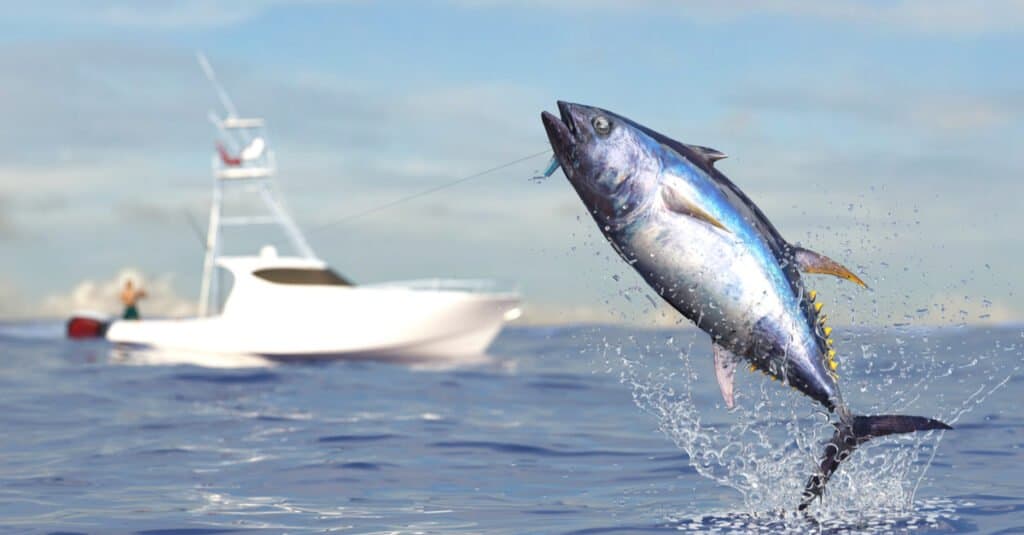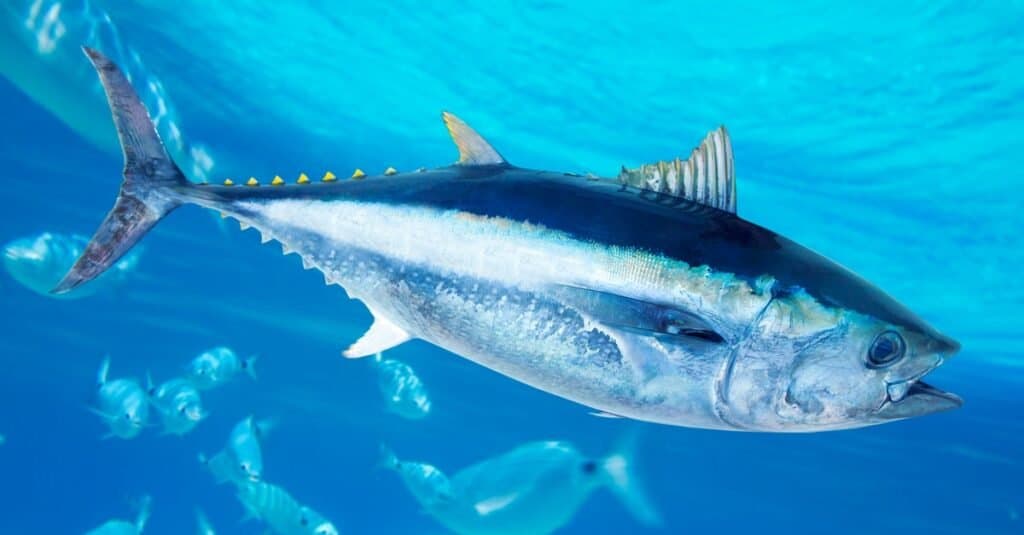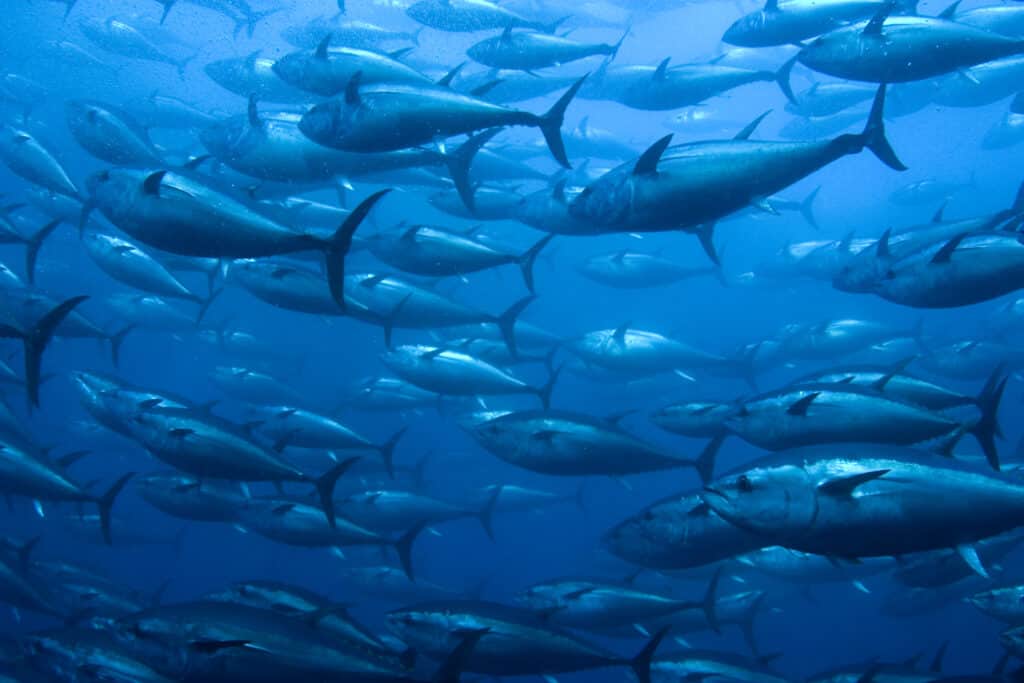The largest bluefin tuna in Louisiana was huge!
Bluefin tuna, an extraordinary species admired for its impressive size, speed, and agility, are sought after worldwide for their high-quality meat. These powerful fish can be found in oceans across the globe, playing a vital role in maintaining the balance of marine ecosystems.
Today, we discover the largest bluefin tuna in Louisiana. We also dive deep into the world of bluefin tuna, exploring their presence in Louisiana and the many challenges they face. Let’s take a look at the efforts being made to protect and conserve this truly remarkable species.
Get ready to learn about these amazing fish and their place in Louisiana’s waters!
The Largest Bluefin Tuna Ever Caught in Louisiana

Angler Ron Roland caught a 1,152-pound bluefin tuna 30 miles south of South Pass in May 2003.
©bekirevren/Shutterstock.com
The largest bluefin tuna ever caught in Louisiana weighed an impressive 1,152 lbs. Angler Ron Roland caught the tuna 30 miles south of South Pass in May 2003. The trophy won the 2003 LOWA Fish of the Year award. Roland’s catch dethroned the then record held by angler Darlene Fisher. Fisher caught the 891-pound tuna in May 1981.
Further, in Louisiana the bluefin tuna fish species have established a notable presence, impacting both the region’s marine ecosystem and the local fishing industry. Louisiana’s waters provide a suitable habitat for these migratory fish, where they search for prey and contribute to the region’s rich biodiversity. The local fishing industry, in turn, benefits from the presence of bluefin tuna, creating jobs and supporting the economy.
Lastly, bluefin tuna in Louisiana, like their counterparts in other parts of the world, face numerous challenges that threaten their survival. Issues like overfishing, climate change, and pollution continue to put immense pressure on their populations.
As a result, conservation efforts and sustainable practices are being implemented to safeguard this valuable species and ensure their continued presence in Louisiana’s waters.
Where is South Pass, Louisiana, Located on a Map?
South Pass, Louisiana, is a small community located in Plaquemines Parish, Louisiana. It is situated at the southernmost tip of the Mississippi River Delta and acts as a major access point to offshore oil rigs in the Gulf of Mexico. While it may be difficult to provide detailed directions without knowing your starting location, there are several main routes that can lead you to South Pass.
If you are traveling from New Orleans or Baton Rouge, take I-10 East towards Slidell and then merge onto I-510 South towards Chalmette/LA-39 S. Continue on LA-39 S until you reach Venice, where you will turn right onto LA-23 S. Follow this road through Boothville-Venice until you reach Port Sulphur. From here, continue south on LA-23 for approximately 20 miles until you reach South Pass.
Alternatively, if coming from Lafayette or Lake Charles area in western Louisiana, one could take US 90 East towards Houma and then follow signs for Golden Meadow/Port Fourchon along LA Highway 1 for approximately 60 miles before reaching Grand Isle. From Grand Isle, continue northeast along State Route 1 (LA Hwy), which will eventually turn into State Route 3090 (LA Hwy). After roughly another hour’s drive heading northeastward along State Route 3090 (LA Hwy), one would arrive at South Pass.
No matter which route you choose to take when visiting South Pass, be sure to enjoy the scenic views.
The Largest Bluefin Tuna Ever Caught Worldwide
The largest bluefin tuna ever caught worldwide weighed an astounding 1,496 lbs. Fisherman Ken Fraser caught the tuna2 in 1979 off the coast of Nova Scotia in Canada. Fraser reportedly took 45 minutes to reel in the tuna and another 10 hours to dehydrate it.
Background on Bluefin Tuna

Bluefin tuna are known for their impressive size and weight.
©Al McGlashan/Shutterstock.com
Let’s start by getting to know bluefin tuna a bit better. These incredible fish have some truly amazing features that make them stand out in the vast ocean.
Size and Weight
Bluefin tuna are known for their impressive size and weight. They can grow up to 10 ft. long and weigh over 1,000 lbs., making them one of the largest species of tuna out there. These giants of the sea are truly a sight to behold and are revered by both professional and recreational anglers.
Speed and Endurance
Not only are bluefin tuna big, but they’re also incredibly fast swimmers. They can reach speeds of up to 40 miles per hour, which comes in handy when chasing their prey. In addition, their powerful muscles and streamlined bodies allow them to glide effortlessly through the water, making them formidable predators.
Warm-blooded Adaptations
Interestingly, bluefin tuna are one of the few fish species that are warm-blooded. This unique adaptation allows them to regulate their body temperature, enabling them to thrive in a wide range of water temperatures. As a result, bluefin tuna can be found in various parts of the world, from the cold waters of the North Atlantic to the warmer Gulf of Mexico.
Where Are Bluefin Tuna Found?

Bluefin tuna are globally distributed, inhabiting oceans worldwide, including the Atlantic Ocean from Norway’s chilly waters to the Gulf of Mexico’s warmer currents.
©lunamarina/Shutterstock.com
Now that we’ve got a good grasp on the background of bluefin tuna let’s explore their distribution and habitat. These fascinating fish can be found in different parts of the world, each with its unique conditions. We’ll also take a closer look at the presence of bluefin tuna in Louisiana’s waters and what makes it an ideal environment for them.
Global Range
Bluefin tuna have a widespread distribution, inhabiting various oceans across the globe. They’re commonly found in the Atlantic Ocean, from the cold waters off the coast of Norway to the warm currents of the Gulf of Mexico. Bluefin tuna are migratory, traveling vast distances in search of food and suitable spawning grounds.
Louisiana’s Waters
Louisiana provides a prime habitat for bluefin tuna, thanks to its warm waters and abundant food sources. The state’s coastal waters, particularly the Gulf of Mexico, are home to a diverse range of marine life that supports the bluefin tuna’s diet. Their presence in Louisiana’s waters contributes significantly to the region’s rich biodiversity.
Migration and Spawning
Bluefin tuna are known for their impressive migratory patterns. They traverse thousands of miles throughout their lifetime, often crossing entire oceans in search of food and spawning grounds. While their exact spawning locations are still somewhat of a mystery, it’s believed that the Gulf of Mexico, including areas near Louisiana, plays a critical role in their reproductive cycle.
Bluefin Tuna Diet
To better understand the impact bluefin tuna have on their environment, it’s important to delve deeper into their dietary habits. These skilled hunters possess unique adaptations that allow them to pursue a diverse array of prey.
Preferred Prey
Bluefin tuna have a diverse diet, consisting of a variety of fish, cephalopods, and crustaceans. Some of their preferred prey items include:
- Fish. Bluefin tuna primarily feed on smaller fish species, such as herring, mackerel, and sardines. These fish are abundant in the open ocean and provide a substantial source of nutrition for the bluefin tuna.
- Cephalopods. Squid is another common prey item for bluefin tuna. Their soft bodies and high protein content make them an attractive food source for these fast-swimming predators.
- Crustaceans. Although less common, bluefin tuna occasionally consume crustaceans like shrimp and crabs. These invertebrates can provide additional nutrients and variety to the tuna’s diet.
Hunting Techniques
Bluefin tuna employ several hunting techniques to capture their prey. Their speed, agility, and keen eyesight make them highly effective predators in the open ocean.
- Ambush. Bluefin tuna often rely on stealth to approach their prey, using their streamlined bodies to minimize water resistance and make sudden bursts of speed to catch their target off-guard.
- Chasing. When pursuing faster prey, such as mackerel or squid, bluefin tuna use their incredible speed and endurance to close the distance and capture their quarry.
- Herding. Bluefin tuna are known to herd schools of smaller fish, like sardines or herring, towards the surface or against other barriers, making it easier to pick off individual prey items.
Bluefin Tuna Predators

Bluefin tuna (Thunnus thynnus), saltwater fish in the Mediterranean. This type of rare fish is a fierce predator that feeds on herring, mackerel, and other ocean fish.
©lunamarina/Shutterstock.com
Bluefin tuna, despite being formidable hunters, face threats from various predators in the ocean. Let’s take a closer look at their natural predators, their hunting strategies, and the role they play in the ecosystem. We’ll also discuss the impact of human activities on bluefin tuna populations and the significance of maintaining a balance between predators and prey.
Natural Predators
While bluefin tuna are often considered top predators in the ocean, they’re not exempt from threats posed by other marine creatures. In the complex marine food web, these natural predators play a crucial role in maintaining balance and ensuring a healthy ecosystem. Let’s explore some of the key natural predators of bluefin tuna and how they contribute to the dynamic underwater world.
- Sharks. Large shark species are among the most well-known predators of bluefin tuna. Some of the most common shark species that prey on bluefin tuna include great white sharks and mako sharks. Known for their size and power, great white sharks are capable of preying on even the largest bluefin tuna. They use their speed and ambush tactics to catch their prey off-guard, delivering a powerful bite that can incapacitate the tuna. The mako shark, one of the fastest sharks in the ocean, is another predator of bluefin tuna. They rely on their incredible speed and agility to chase down and capture tuna, often leaping out of the water during high-speed pursuits.
- Killer whales (orcas). Killer whales occasionally include bluefin tuna in their diet, although this is less common than predation by sharks. As highly intelligent marine mammals, orcas use cooperative hunting techniques to surround and capture their prey, which can include bluefin tuna.
Human Impact on Bluefin Tuna Populations
Human activities, such as overfishing, pose a significant threat to bluefin tuna populations. Excessive fishing to meet the high demand for their prized meat can lead to a decline in their numbers, disrupting the delicate balance between predators and prey in the marine ecosystem. In addition, bycatch during fishing operations can also contribute to the decline in bluefin tuna populations.
Threats to Bluefin Tuna in Louisiana
Bluefin tuna face various challenges in Louisiana’s waters, as they do in other parts of their range. Let’s examine some of the most pressing threats to bluefin tuna in the region and the potential consequences these challenges pose for the species and the marine ecosystem as a whole.
Overfishing
One of the most significant threats to bluefin tuna in Louisiana is overfishing. High demand for their meat, particularly in sushi and sashimi dishes, has driven intense fishing pressure on bluefin tuna populations. This excessive fishing can result in population declines, reducing their numbers and potentially disrupting the balance of the marine ecosystem.
Bycatch
Bycatch is another threat to bluefin tuna in Louisiana. When fishing for other species, it’s not uncommon for bluefin tuna to be accidentally caught in fishing gear like nets or longlines. This unintentional capture can contribute to the decline of bluefin tuna populations and complicate conservation efforts.
Habitat Degradation
Habitat degradation poses yet another challenge to bluefin tuna in Louisiana. Coastal development, pollution, and other human activities can damage the delicate marine habitats that support bluefin tuna and their prey. As their habitat quality declines, so too does the availability of food and the overall health of the ecosystem.
Climate Change
Climate change is an emerging threat to bluefin tuna, with potentially far-reaching consequences. As ocean temperatures rise, bluefin tuna may be forced to seek out new habitats, altering their distribution and migration patterns. Additionally, climate change can impact the abundance and distribution of their prey, further affecting bluefin tuna populations.
Conservation and Management Efforts

Promoting and adopting sustainable fishing practices is crucial for conserving bluefin tuna.
©iStock.com/DeepAqua
Given the numerous threats bluefin tuna face in Louisiana and beyond, it’s essential to implement conservation and management efforts to protect this iconic species.
In this section, we’ll discuss various initiatives aimed at preserving bluefin tuna populations and maintaining the health of the marine ecosystem in which they play such a vital role.
Sustainable Fishing Practices
One of the most critical steps in conserving bluefin tuna is promoting and adopting sustainable fishing practices. These practices can help minimize overfishing and bycatch, ensuring that bluefin tuna populations are maintained at healthy levels. Some sustainable fishing methods include:
- Catch limits. Implementing catch limits can help regulate the number of bluefin tuna caught each year, preventing overfishing and allowing populations to recover.
- Selective fishing gear. Utilizing fishing gear that targets specific species can help reduce bycatch. It can also minimize the impact on non-target species, including bluefin tuna.
Marine Protected Areas
Establishing marine protected areas (MPAs) can provide critical habitat for bluefin tuna, as well as other marine species. In addition, MPAs can serve as breeding grounds, nurseries, and feeding areas for bluefin tuna, promoting healthy population growth and helping to maintain the balance of the ecosystem.
International Cooperation
Because bluefin tuna are highly migratory, spanning vast distances across international waters, it’s crucial to foster international cooperation in their conservation. Joint efforts bring together various countries to develop and implement management measures aimed at protecting bluefin tuna and their habitats.
Education and Awareness
Raising public awareness about the importance of bluefin tuna and the challenges they face is a key component of their conservation. By educating the public on the ecological significance of bluefin tuna, sustainable seafood choices, and responsible fishing practices, we can empower individuals to make a positive impact on the health of our oceans and the species that inhabit them.
Key Takeaways
Bluefin tuna holds a special place in Louisiana’s marine ecosystem and local fishing industry. Despite facing multiple challenges like overfishing, climate change, and pollution, efforts to protect and conserve this amazing species are underway. It’s crucial that we continue to support and participate in sustainable fishing practices and conservation initiatives to ensure a thriving future for these remarkable fish.
The photo featured at the top of this post is © iStock.com/DeepAqua
Thank you for reading! Have some feedback for us? Contact the AZ Animals editorial team.






